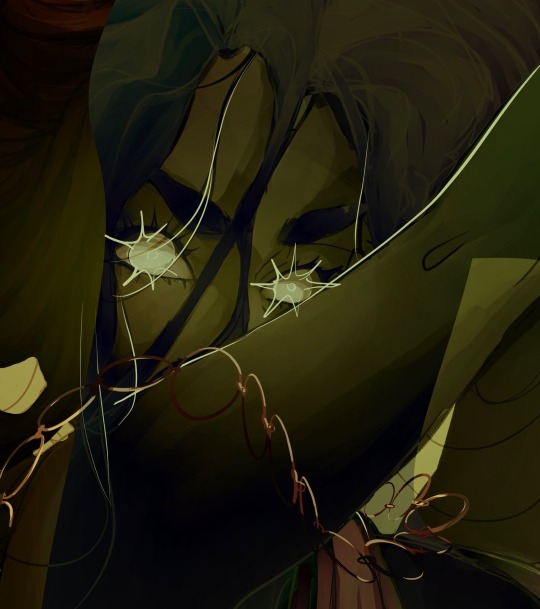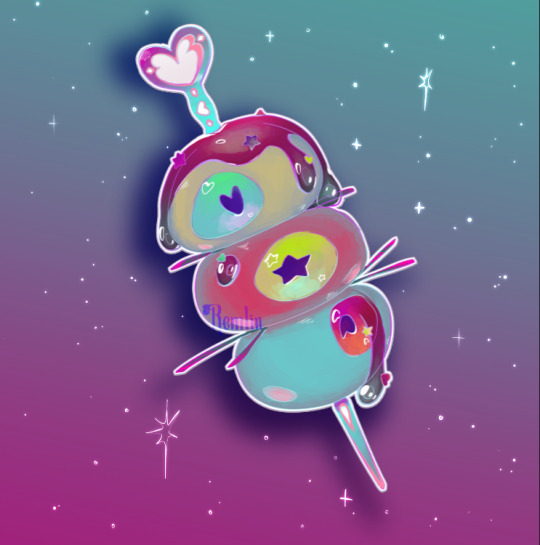#remlin art
Text

About this piece- CW: mental health
This painting depicts some graphic feelings I've had about my body my whole life- when I was in my early teens I started having persistent intrusive imagery about my body including but not limited to ripping myself apart, and the hazy perception I have when it comes to the world. so this painting was a way for me to try and capture that feeling- I don't know if it perfectly captures it but when am I ever satisfied with my work? You can read my entire deep dive about my psyche in my Instagram post or on my Newgrounds. Really happy with the direction I'm now taking with my art.
I hope you all have a love day, and enjoy my painting.
-Rem
#digital art#clip studio paint#csp#angel#sword#gore#stab#slain#vent art#paint your feelings#remlin#remlin art#remlinng#remlin.ig#remlinx#wings#surreal#surrealism#surrealist#painting#digital painting#digital illustration#digital drawing
3 notes
·
View notes
Text

Remlin doodle (ㆁωㆁ)
9 notes
·
View notes
Photo

Remi goin absolutely fucking feral.
you've heard of gremlins.
This? this is a Remi Gremlin.
a Remlin. :0
fear her.
fear the shortstack.
Art (c) mine
Remi (c) mine
Helluva boss (c) vivz
I kinda keep forgetting I have a tumblr LMAO
13 notes
·
View notes
Text
𝒪𝒞 𝒫𝑅𝒪𝐹𝐼𝐿𝐸 | 𝐻𝐼𝒯𝒞𝐻

Name: Hitch
Age: 20
Jinkie: Their earrings can be used for healing allies and briefly stunning enemies.

Relationships:
| Zanka ~ Love interest

Allies:
| The Janitors (including Rudo, Delmon, Engine, Riyou, Semiu, Korvus, Griss, Follo, Thoum, August, etc.)
| Remlin

Enemies:
| Vandals (including Jabber and Kutohni)
| Amo
| Heaven's residents

Lore:
| Hitch is from Canvas Town. Her old Jinkie used to be a pair of sneakers that they painted on a lot when they were bored. When they met Zanka and discovered that they were a Giver, they left to live and train with the Janitors, but lost their sneakers in the process. After that, they were looking to create a new Jinkie, but nothing seemed to be important enough.
| When Zanka and Hitch first started dating, he bought a pair of blue earrings for both of them-- the color matches Hitch's hair, so he thought it was perfect. Throughout the years, as Hitch has taken care of them, the earrings became their Jinkies. Now, the earrings can extend up to a maximum of seven feet when Hitch is at full strength; and the earrings themselves have the ability to heal allies (left) and briefly stun enemies (right) by using the extensions of the earrings like a whip, wrapping it around the target. Depending on Hitch's strength at any given point, the healing can be faster or slower. Also depending on their strength, the stun can be more disorienting or simply off-putting. Hitch can extend and recall the earrings at will. The ropes of the earrings can be used simultaneously, but the energy output is more strained, resulting in less quality.
| Hitch's full face mask resembles the look of Angels, which is ironic considering how much they hate those up in Heaven. The mask is beautiful, golden, and heavily influenced by the art in Canvas Town where Hitch is from.
| Hitch's dangerzone outfit would include a long trench coat like Engines, but this one used to be white, though it has since then turned a light brown due to the dust and dirt that's collected on it over the years. On the hood of the trench coat, Hitch painted a golden halo to match the angel theme of her full face mask.
| Engine caught Zanka and Hitch fucking once-- Neither of them stopped what they were doing. Engine just leaned against the doorframe.
#op#gachi#zanka#gachiakuta#zanka headcanon#zanka gachiakuta#zanka nijik#gachiakuta headcanon#gachiakuta oc#gachiakuta fanfic#zanka oc#zanka fanfic
3 notes
·
View notes
Photo






MY ART FIGHT PIECES! (including: @neochaos, remlin (dA), @bluud, @ohboy, @shuddersome, catboynewt (twt)
3 notes
·
View notes
Photo



my fav art fights from this year! not going to post the others because im not very proud of those (x) (x) (x)
77 notes
·
View notes
Text
What is Applied Behavior Analysis (ABA)?
Applied Behavior Analysis (ABA) is probably the best-known, best-researched treatment, and the only treatment for children with autism that has produced significant and comprehensive improvements, including recovery.
ABA is a specialized area within the field of Psychology. The goal of ABA is to apply specific psychological principles (eg, reinforcement, cues, generalization, etc.) to issues that are socially important (such as autism) to produce meaningful change (Baer, Wolf, & Risley, 1968/1987 ).
“ABA involves breaking down all skills into small, discrete tasks, taught in a very structured and hierarchical way. Fundamental to the successful application of this method is the art of differential reinforcement. That is, the therapist or parents learn to systematically reward or reinforce desired behaviors and to ignore, redirect, or discourage inappropriate behaviors. Also critical to any well-managed behavioral program is close supervision by the therapist of what works and what does not work. Data on all of the child's learning is recorded periodically and the therapist adjusts the programs and teaching protocol with respect to what the data indicates about the child's progress. "(Maurice, Green & Luce, 1996)
In an ABA program, the lessons to be taught are divided into their simplest elements. ABA focuses on systematically teaching small, measurable units of behavior. At first, the child may be rewarded for doing something close to the desired response. Over time, as the child masters the lesson, expectations rise, and primary reinforcers (such as bits of food) are replaced by social reinforcers (hugs, praise, etc.). As the child masters the skill and generalizes it, she reinforces herself. ABA focuses on increasing appropriate behaviors and celebrating successes and minimizing attention and energy wasted on inappropriate behaviors. Creating a fun and positive learning environment facilitates the learning process in all domains, including social, play, and language. In this way, simple responses are systematically integrated into complex and fluid combinations of typical age-appropriate responses.
Why use ABA?
The following paragraphs are excerpts from Chapter 3 of Maurice, Green and Luce's book "Behavioral Interventions for Young Children with Autism, 1996."
Historically, most people with autism have required extensive treatment and support throughout their lives (Rapin, 1991; Remlin, 1994; Rutter, 1970; Rutter and Schopler, 1987; Szatmari et al., 1989). Today, the widely held position is that autism is a "severely disabling lifelong developmental disability." It is considered treatable; in fact, a wide variety of treatments, therapies, and techniques are claimed to help (or even cure) people with autism, and new ones are regularly invented (Autism Society of America, 1995).
However, until recently, none of those treatments has provided a solid and realistic basis for changing the view that autism is a permanent disability. Several studies have now shown that a treatment approach - early and intensive instruction using Applied Behavior Analysis methods - can result in dramatic improvements for children with autism: successful integration into regular schools for many, completely normal functioning for some (Anderson , Avery, DiPietro, Edwards and Christian, 1987; Birnbrauer and Leach, 1993; Fenske, Zalenski, Krantz, McClannahan, 1985; Harris, Handleman, Gordon, Kristoff and Fuentes, 1991; Lovaas, 1987; Maurice, 1993; McEachin, Smith , and Lovaas, 1993; Perry, Cohen, and DeCarlo, 1995). In fact, there is abundant scientific evidence that applied behavioral analysis methods can produce comprehensive and lasting improvements in many important skill areas for most people with autism, regardless of age. No other treatment for autism offers comparable evidence of effectiveness (Lovaas and Smith, 1989; Schreibman, 1988; Shreibman, Charlop, and Milstein, 1993; Smith, 1993).
There is little doubt that early intervention based on the principles and practices of applied behavior analysis can produce important, comprehensive, lasting and significant improvements in many important domains for a large proportion of children with autism. For some, these improvements may amount to the achievement of completely normal intellectual, social, academic, communicative, and adaptive functioning. In fact, a vast majority of young children with autism benefit from early behavioral intervention. Most show substantial improvements in many useful and adaptive skill areas and a reduction in problem behaviors. Only a small portion (about 10% of those studied so far) have been found to achieve little or no improvement despite intensive efforts (e.g. Anderson, et al., 1987; Birnbrauer and Leach, 1993; Lovaas, 1987; McEachin et al., 1993).
There is strong evidence that behavioral intervention is more effective for young children with autism than no intervention, and more effective than typical early education services and a variety of other therapies.
How does ABA work?
Maurice (1996) describes ABA as the breakdown of all skills into small, discrete tasks. These tasks are then taught in a highly structured and hierarchical way. As Maurice (1996) indicates, success depends largely on the application of differential reinforcement. Through the use of differential reinforcement, the therapist, parent, or caregiver learns how to consistently reward or reinforce desired behaviors and to ignore, redirect, or discourage behaviors that are inappropriate.
ABA programs are modified to suit the particular child. Once the basic principles of ABA are learned, they can be applied to all areas of a child's development, including behavior management, communication, social interaction, intellectual growth, among other skills.
Is ABA effective?
Perhaps the most frequently asked question about ABA is "Does it work?" Numerous studies in professional journals document that early intensive behavioral intervention can produce unprecedented results for young children with autism spectrum disorders (Maurice et. Al. 1996). The groundbreaking Lovaas study from 1987 showed that 47% of children who received early intensive behavioral intervention achieved normal cognitive and intellectual functioning and were able to complete first grade with typical peers and without special education supports. These children achieved normal intellectual and educational functioning and could not be distinguished from their peers. A follow-up study on the children who made up 47% revealed that they maintained their earnings into adulthood and were indistinguishable from their peers.
Additionally, research by the Wisconsin Early Autism Project confirmed that more than one in three children who participated in an extensive ABA program at home achieved the IQ and social functioning of their typical peers. In all, the children in the ABA group averaged a 22 point gain in IQ points in the first year. In contrast, children in typical special education classes showed a 7 point loss in IQ points during the first year (Sallows & Graupner, 1999).
The Surgeon General's report on mental health stated: “Thirty years of research demonstrated the efficacy of Autism in reducing inappropriate behavior and increasing communication, learning, and appropriate social behavior.
While it may be true that the best time to start treatment is at a very young age, most older children can also benefit from intensive behavioral intervention (Leaf & McEachin, 1999).
However, it should be noted that intensive behavioral intervention is by no means a "cure" for autism. No amount of behavioral therapy can cure the underlying and hitherto unknown etiology of autism. Intensive behavioral intervention is effective in remediating many symptoms of autism, thus recovering children in the sense that their behavior may become "indistinguishable from their peers."
0 notes
Text

Eye for Sweets sticker 👁️🍡💛🩷🩵
I'm going to be printing it and putting it up in my shop soon! They're going to be my first stickers ever, and I can't wait to get them out 💜
#sticker#store#shop#art#digital art#sweets#dango#candy#small business#small artist#clip studio paint#candy gore#remlin#remlinng#remlin.ig#remlinx#remlin art#I've been wanting to make this sticker for EVER
1 note
·
View note
Text

I've been thinking non-stop about these two 👉👈
6 notes
·
View notes